Mostrar el registro sencillo del ítem
dc.contributor.author
Kwon, TaeOh
dc.contributor.author
Shibata, Hideaki
dc.contributor.author
Kepfer Rojas, Sebastian
dc.contributor.author
Schmidt, Inger K.
dc.contributor.author
Larsen, Klaus S.
dc.contributor.author
Beier, Claus
dc.contributor.author
Berg, Björn
dc.contributor.author
Verheyen, Kris

dc.contributor.author
Lamarque, Jean-Francois
dc.contributor.author
Hagedorn, Frank
dc.contributor.author
Eisenhauer, Nico

dc.contributor.author
Djukic, Tea
dc.contributor.author
Peri, Pablo Luis

dc.date.available
2022-08-24T16:30:28Z
dc.date.issued
2021-07
dc.identifier.citation
Kwon, TaeOh; Shibata, Hideaki; Kepfer Rojas, Sebastian; Schmidt, Inger K.; Larsen, Klaus S.; et al.; Effects of climate and atmospheric nitrogen deposition on early to mid-term stage litter decomposition across biomes; Frontiers Media; Frontiers in Forests and Global Change; 4; 7-2021; 1-18
dc.identifier.uri
http://hdl.handle.net/11336/166456
dc.description.abstract
Litter decomposition is a key process for carbon and nutrient cycling in terrestrial ecosystems and is mainly controlled by environmental conditions, substrate quantity and quality as well as microbial community abundance and composition. In particular, the effects of climate and atmospheric nitrogen (N) deposition on litter decomposition and its temporal dynamics are of significant importance, since their effects might change over the course of the decomposition process. Within the TeaComposition initiative, we incubated Green and Rooibos teas at 524 sites across nine biomes. We assessed how macroclimate and atmospheric inorganic N deposition under current and predicted scenarios (RCP 2.6, RCP 8.5) might affect litter mass loss measured after 3 and 12 months. Our study shows that the early to mid-term mass loss at the global scale was affected predominantly by litter quality (explaining 73% and 62% of the total variance after 3 and 12 months, respectively) followed by climate and N deposition. The effects of climate were not litter-specific and became increasingly significant as decomposition progressed, with MAP explaining 2% and MAT 4% of the variation after 12 months of incubation. The effect of N deposition was litter-specific, and significant only for 12-month decomposition of Rooibos tea at the global scale. However, in the temperate biome where atmospheric N deposition rates are relatively high, the 12- month mass loss of Green and Rooibos teas decreased significantly with increasing N deposition, explaining 9.5% and 1.1% of the variance, respectively. The expected changes in macroclimate and N deposition at the global scale by the end of this century are estimated to increase the 12-month mass loss of easily decomposable litter by 1.1– 3.5% and of the more stable substrates by 3.8–10.6%, relative to current mass loss. In contrast, expected changes in atmospheric N deposition will decrease the mid-term mass loss of high-quality litter by 1.4–2.2% and that of low-quality litter by 0.9–1.5% in the temperate biome. Our results suggest that projected increases in N deposition may have the capacity to dampen the climate-driven increases in litter decomposition depending on the biome and decomposition stage of substrate.
dc.format
application/pdf
dc.language.iso
eng
dc.publisher
Frontiers Media

dc.rights
info:eu-repo/semantics/openAccess
dc.rights.uri
https://creativecommons.org/licenses/by/2.5/ar/
dc.subject
TEA BAG
dc.subject
GREEN TEA
dc.subject
ROOIBOS TEA
dc.subject
LITTER DECOMPOSITION
dc.subject
CARBON TURNOVER
dc.subject
NITROGEN DEPOSITION
dc.subject
TEACOMPOSITION INITIATIVE
dc.subject.classification
Ecología

dc.subject.classification
Ciencias Biológicas

dc.subject.classification
CIENCIAS NATURALES Y EXACTAS

dc.title
Effects of climate and atmospheric nitrogen deposition on early to mid-term stage litter decomposition across biomes
dc.type
info:eu-repo/semantics/article
dc.type
info:ar-repo/semantics/artículo
dc.type
info:eu-repo/semantics/publishedVersion
dc.date.updated
2022-08-16T18:15:52Z
dc.identifier.eissn
2624-893X
dc.journal.volume
4
dc.journal.pagination
1-18
dc.journal.pais
Suiza

dc.journal.ciudad
Lausana
dc.description.fil
Fil: Kwon, TaeOh. Hokkaido University; Japón
dc.description.fil
Fil: Shibata, Hideaki. Hokkaido University; Japón
dc.description.fil
Fil: Kepfer Rojas, Sebastian. Universidad de Copenhagen; Dinamarca
dc.description.fil
Fil: Schmidt, Inger K.. Universidad de Copenhagen; Dinamarca
dc.description.fil
Fil: Larsen, Klaus S.. Universidad de Copenhagen; Dinamarca
dc.description.fil
Fil: Beier, Claus. Universidad de Copenhagen; Dinamarca
dc.description.fil
Fil: Berg, Björn. University of Helsinki; Finlandia
dc.description.fil
Fil: Verheyen, Kris. University of Ghent; Bélgica
dc.description.fil
Fil: Lamarque, Jean-Francois. National Center for Atmospheric Research; Estados Unidos
dc.description.fil
Fil: Hagedorn, Frank. Swiss Federal Institute for Forest, Snow and Landscape Research; Suiza
dc.description.fil
Fil: Eisenhauer, Nico. German Centre for Integrative Biodiversity Research; Alemania. Universitat Leipzig; Alemania
dc.description.fil
Fil: Djukic, Tea. Swiss Federal Institute for Forest, Snow and Landscape Research; Suiza
dc.description.fil
Fil: Peri, Pablo Luis. Consejo Nacional de Investigaciones Científicas y Técnicas. Centro de Investigaciones y Transferencia de Santa Cruz. Universidad Tecnológica Nacional. Facultad Regional Santa Cruz. Centro de Investigaciones y Transferencia de Santa Cruz. Universidad Nacional de la Patagonia Austral. Centro de Investigaciones y Transferencia de Santa Cruz; Argentina
dc.journal.title
Frontiers in Forests and Global Change
dc.relation.alternativeid
info:eu-repo/semantics/altIdentifier/url/https://www.frontiersin.org/articles/10.3389/ffgc.2021.678480/full
dc.relation.alternativeid
info:eu-repo/semantics/altIdentifier/doi/http://dx.doi.org/10.3389/ffgc.2021.678480
Archivos asociados
